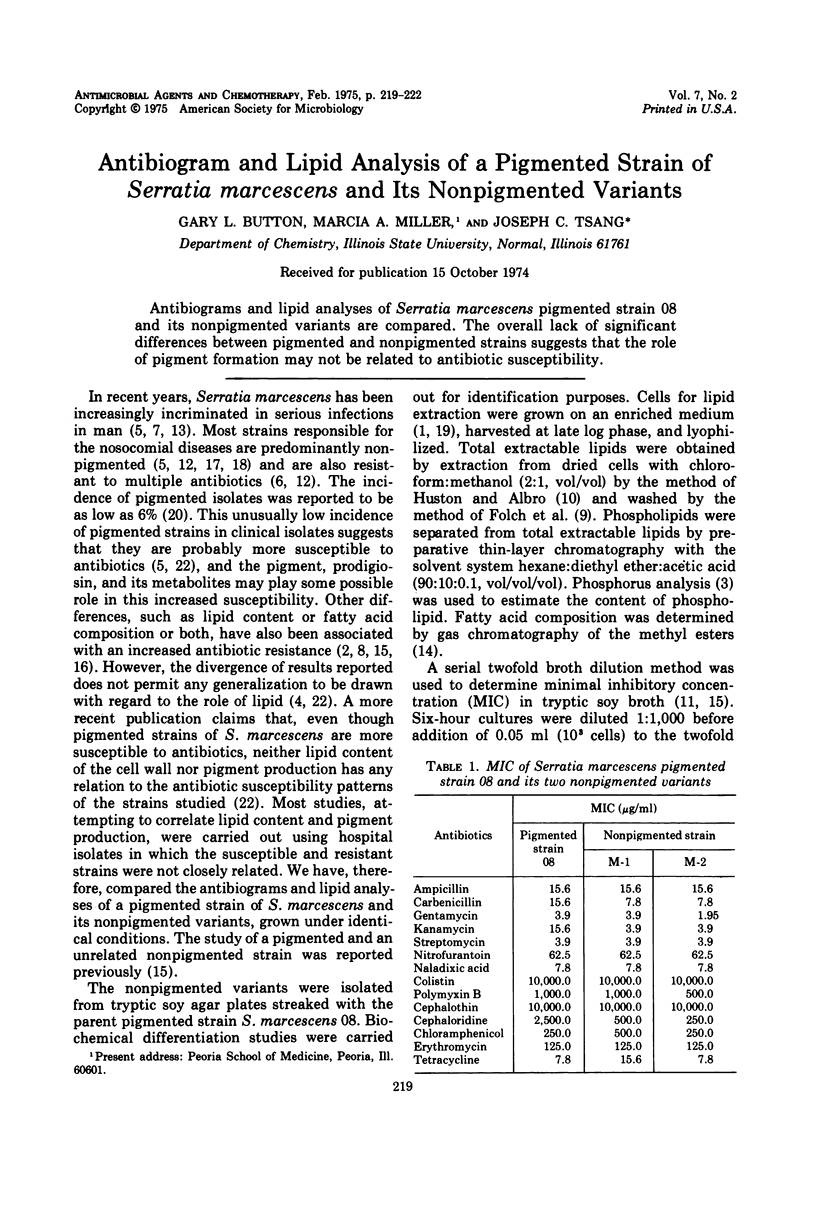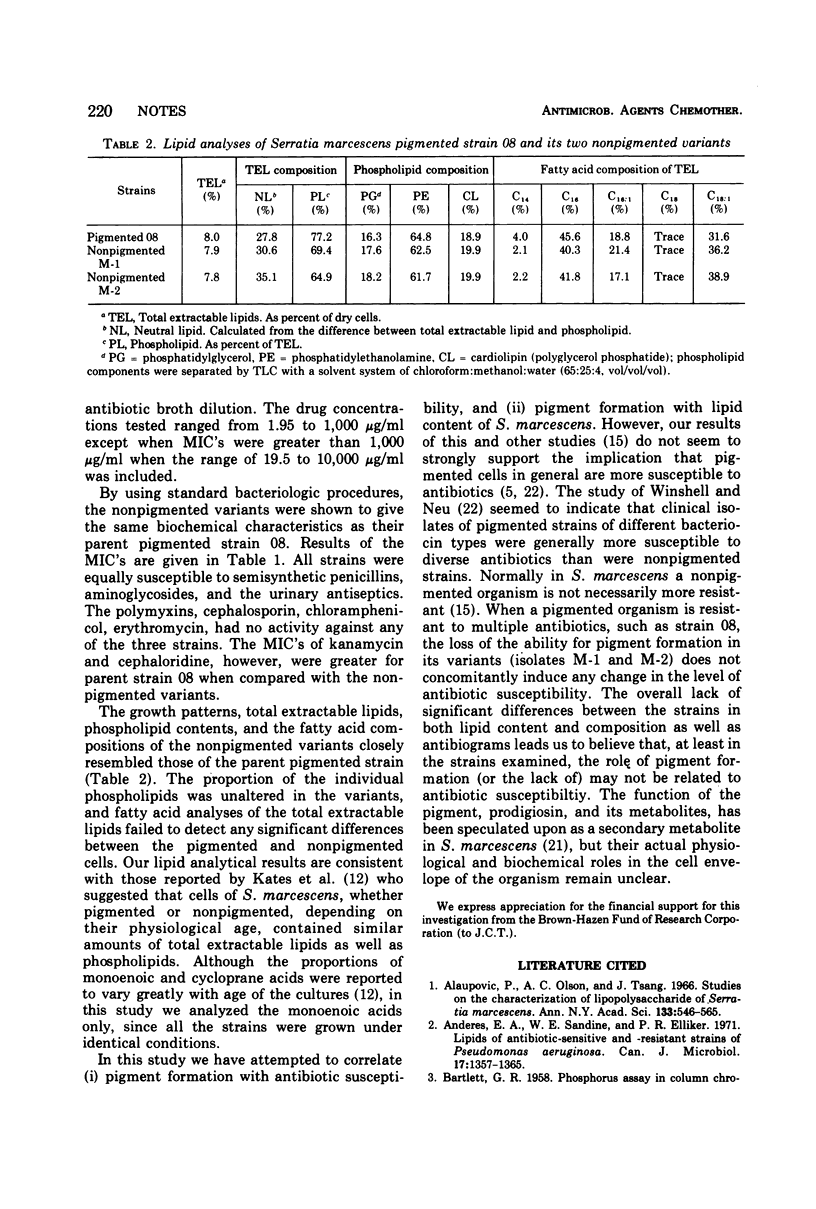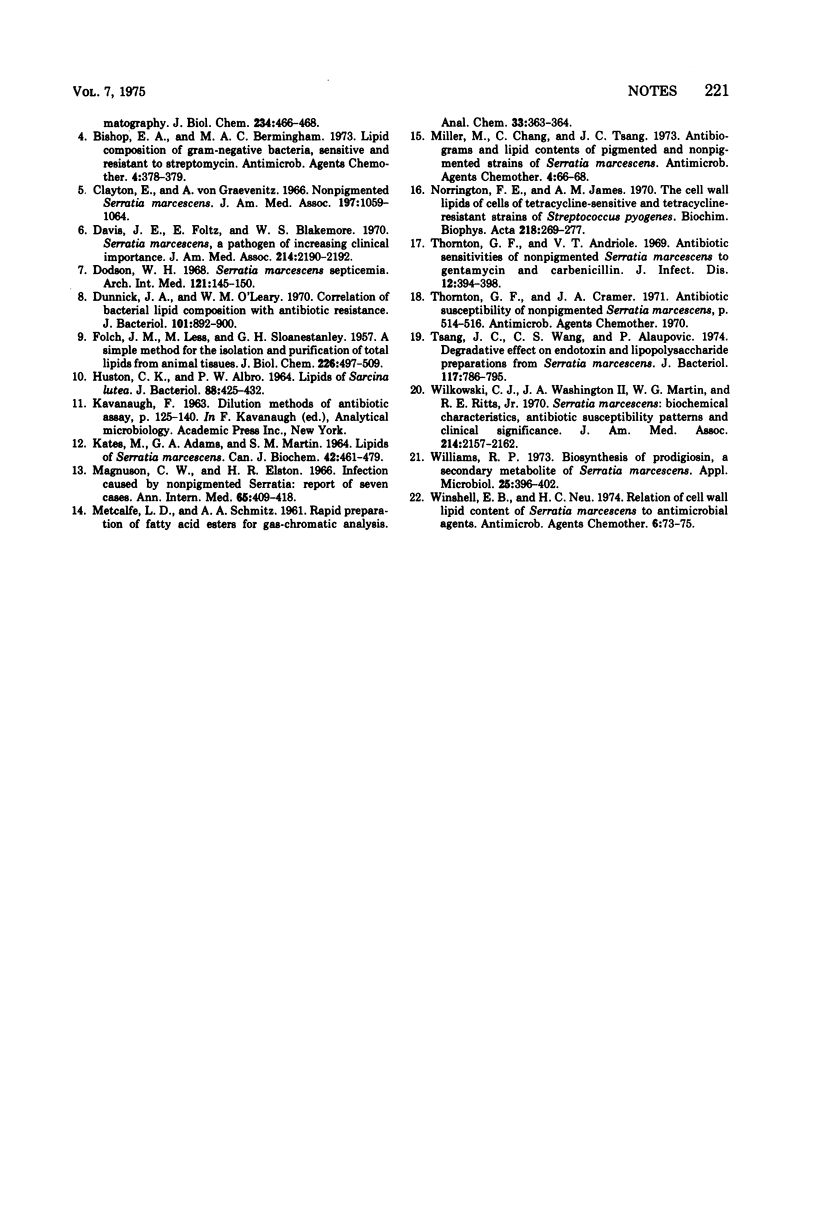Abstract
Antibiograms and lipid analyses of Serratia marcescens pigmented strain 08 and its nonpigmented variants are compared. The overall lack of significant differences between pigmented and nonpigmented strains suggests that the role of pigment formation may not be related to antibiotic susceptibility.
Full text
PDF


Selected References
These references are in PubMed. This may not be the complete list of references from this article.
- Alaupovic P., Olson A. C., Tsang J. Studies on the characterization of lipopolysaccharides from two strains of Serratia marcescens. Ann N Y Acad Sci. 1966 Jun 30;133(2):546–565. doi: 10.1111/j.1749-6632.1966.tb52388.x. [DOI] [PubMed] [Google Scholar]
- Anderes E. A., Sandine W. E., Elliker P. R. Lipids of antibiotic-sensitive and -resistant strains of Pseudomonas aeruginosa. Can J Microbiol. 1971 Nov;17(11):1357–1365. doi: 10.1139/m71-217. [DOI] [PubMed] [Google Scholar]
- BARTLETT G. R. Phosphorus assay in column chromatography. J Biol Chem. 1959 Mar;234(3):466–468. [PubMed] [Google Scholar]
- Bishop E. A., Bermingham M. A. Lipid composition of gram-negative bacteria, sensitive and resistant to streptomycin. Antimicrob Agents Chemother. 1973 Sep;4(3):378–379. doi: 10.1128/aac.4.3.378. [DOI] [PMC free article] [PubMed] [Google Scholar]
- Clayton E., Von Graevenitz A. Nonpigmented Serratia marcescens. JAMA. 1966 Sep 26;197(13):1059–1064. [PubMed] [Google Scholar]
- Davis J. T., Foltz E., Blakemore W. S. Serratia marcescens. A pathogen of increasing clinical importance. JAMA. 1970 Dec 21;214(12):2190–2192. doi: 10.1001/jama.214.12.2190. [DOI] [PubMed] [Google Scholar]
- Dodson W. H. Serratia marcescens septicemia. Arch Intern Med. 1968 Feb;121(2):145–150. [PubMed] [Google Scholar]
- Dunnick J. K., O'Leary W. M. Correlation of bacteria lipid composition with antibiotic resistance. J Bacteriol. 1970 Mar;101(3):892–900. doi: 10.1128/jb.101.3.892-900.1970. [DOI] [PMC free article] [PubMed] [Google Scholar]
- FOLCH J., LEES M., SLOANE STANLEY G. H. A simple method for the isolation and purification of total lipides from animal tissues. J Biol Chem. 1957 May;226(1):497–509. [PubMed] [Google Scholar]
- HUSTON C. K., ALBRO P. W. LIPIDS OF SARCINA LUTEA. I. FATTY ACID COMPOSITION OF THE EXTRACTABLE LIPIDS. J Bacteriol. 1964 Aug;88:425–432. doi: 10.1128/jb.88.2.425-432.1964. [DOI] [PMC free article] [PubMed] [Google Scholar]
- KATES M., ADAMS G. A., MARTIN S. M. LIPIDS OF SERRATIA MARCESCENS. Can J Biochem. 1964 Apr;42:461–479. doi: 10.1139/o64-054. [DOI] [PubMed] [Google Scholar]
- Magnuson C. W., Elston H. R. Infections caused by nonpigmented Serratia. Report of seven cases. Ann Intern Med. 1966 Sep;65(3):409–418. doi: 10.7326/0003-4819-65-3-409. [DOI] [PubMed] [Google Scholar]
- Miller M. A., Chang C. Y., Tsang J. C. Antibiograms and lipid contents of pigmented and nonpigmented strains of Serratia marcescens. Antimicrob Agents Chemother. 1973 Jul;4(1):66–68. doi: 10.1128/aac.4.1.66. [DOI] [PMC free article] [PubMed] [Google Scholar]
- Thornton G. F., Andriole V. T. Antibiotic sensitivities of nonpigmented serratia marcescens to gentamicin and carbenicillin. J Infect Dis. 1969 Apr-May;119(4):393–394. doi: 10.1093/infdis/119.4-5.393. [DOI] [PubMed] [Google Scholar]
- Tsang J. C., Wang C. S., Alaupovic P. Degradative effect of phenol on endotoxin and lipopolysaccharide preparations from Serratia marcescens. J Bacteriol. 1974 Feb;117(2):786–795. doi: 10.1128/jb.117.2.786-795.1974. [DOI] [PMC free article] [PubMed] [Google Scholar]
- Wilkowske C. J., Washington J. A., 2nd, Martin W. J., Ritts R. E., Jr Serratia marcescens. Biochemical characteristics, antibiotic susceptibility patterns, and clinical significance. JAMA. 1970 Dec 21;214(12):2157–2162. doi: 10.1001/jama.214.12.2157. [DOI] [PubMed] [Google Scholar]
- Williams R. P. Biosynthesis of prodigiosin, a secondary metabolite of Serratia marcescens. Appl Microbiol. 1973 Mar;25(3):396–402. doi: 10.1128/am.25.3.396-402.1973. [DOI] [PMC free article] [PubMed] [Google Scholar]
- Winshell E. B., Neu H. C. Relation of cell wall lipid content of Serratia marcescens to resistance to antimicrobial agents. Antimicrob Agents Chemother. 1974 Jul;6(1):73–75. doi: 10.1128/aac.6.1.73. [DOI] [PMC free article] [PubMed] [Google Scholar]


